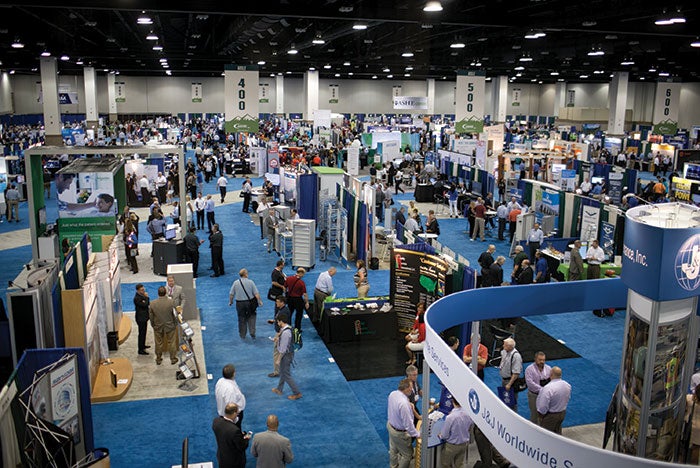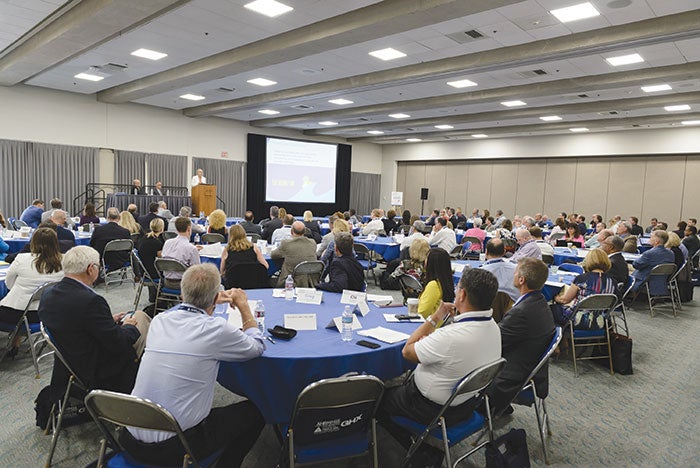Professional societies offer tools for learning and collaboration

The best professional associations, especially in such highly regulated environments as health care, help their members tackle contemporary challenges and keep up with ever-changing rules, requirements and standards. Such organizations provide resources that enable their members to perform their jobs more effectively and efficiently; offer education and credentialing for career advancement; champion the profession to lawmakers, regulators and the public; and elevate the professionalism of the field.
Focused on optimizing the physical environment in which health care is delivered to help ensure top-quality care, the American Society for Healthcare Engineering (ASHE) and the Association for the Healthcare Environment (AHE) are continually refining and adding new programs and other resources to address members’ needs — and help them to serve patients. Affiliated with the American Hospital Association (AHA), these organizations serve as a forum for communication and networking in the demanding field of health care.
ASHE and the AHE organize conferences and a wealth of other educational programs, develop certification and other credentialing initiatives to help members increase — and attest to — their knowledge and skills, and apprise members of the latest regulations, technologies, products and trends of interest to the profession. Additionally, the organizations share insights, solutions and tools for improving operational efficiency.
ASHE and the AHE also help members to hone their communication and leadership skills through materials and workshops on these topics as well as opportunities to volunteer and run for office at the chapter and national levels. Furthermore, through awards programs, the associations publicly recognize facility management, design and environmental services (ES) professionals who exemplify excellence in various realms.
“The number of education sources available in the marketplace today is almost overwhelming, but the quality of the content can vary greatly,” says ASHE Executive Director P.J. Andrus, MBA, CAE. “As a membership organization, our resources and education programs are developed for members by members. As a trusted source of information, we are continually working to create timely, relevant resources that help our members succeed now and in the future.”
Developing facility leaders
Unlike law or medicine, health facility management and ES management do not have prescribed paths of formal education and career advancement. People who choose or discover these fields come from diverse professional backgrounds and have widely differing levels of formal education.
Although having a team of individuals with a variety of experiences, perspectives and skills may be a boon to creative problem-solving, it can make succession planning difficult for health facility directors and managers who are about to retire or who resign for other reasons. “The number of individuals qualified to manage and maintain the health care built environment is diminishing because of retiring baby boomers, burnout and career mobility,” points out ASHE’s new monograph “Succession Planning: Preparing for the Future of Your Facility and Your Career.”
This monograph, which can be ordered from ASHE’s website, is divided into two sections. The first emphasizes the importance of health facilities’ taking a strategic and proactive approach to succession planning rather than waiting until critical managers leave. The document explains step by step how to identify the key positions that need to be covered in a succession plan, the competencies (skills and experiences) required and the current staff members who would be the best candidates.
“The perfect successor is a rare find,” the monograph states, noting that mentoring and continuing education can be provided to a potential successor who meets most of the requirements.
“Being a health care facility director is a very confusing job and it’s a very complex job, and a lot of hospitals don’t really have an idea of the scope of the job these days,” says Jack R. Gosselin, CHFM, FASHE, principal of Mystic, Conn.-based Gosselin/Martin Associates, a search firm that specializes in health facility manager recruitment. When he entered the facility management field more than 35 years ago, Gosselin, who has a degree in mechanical engineering, noticed that many health facility “chief engineers,” as they were called then, were former Navy shipboard boiler operators who transitioned to hospital boiler maintenance after World War II and rose through the facility operations ranks.

ASHE’s Annual Conference & Technical Exhibition attendees have opportunities to see the latest technology firsthand as well as earn continuing professional education units and brainstorm with peers to solve common problems.
While these individuals knew mechanical systems inside and out, facility directors today need to have a thorough understanding of building automation, financial stewardship, environmental sustainability and the communication skills to interact effectively with everyone from maintenance staff to the C-suite, “from boiler room to boardroom,” notes Gosselin, a former ASHE governing board member who played a major role in the monograph’s creation.
Given that formal education is heavily valued in health care settings, having at least a bachelor’s degree is usually a must at the system director or senior director level in health facilities management, Gosselin says. However, people enter the profession via many different routes, including construction trades like plumbing, electrical, and heating, ventilation and air conditioning (HVAC). Intelligent, ambitious individuals who don’t have formal schooling beyond a high-school diploma but have proven themselves to be potential leaders during their years on the job can be encouraged to further their education and should not be excluded from consideration in succession planning, the monograph points out.
The document notes that Owensboro (Ky.) Community and Technical College has an online associate’s degree program in health facility management that working adults can complete remotely. “People who’ve worked their way up through the trades would be really well-positioned for a leadership role if they get this two-year degree,” says Gosselin, noting that ASHE members helped to establish the program.
Many individuals today, though, become exposed to health facility management as a career choice while or after earning degrees in business or construction management. And a growing number of women are entering the profession from fields such as risk management, safety and biomedical engineering, Gosselin adds. Each background brings strengths as well as deficits that can be overcome through coaching, continuing education and the leadership opportunities that ASHE provides.

The trade show floor at ASHE’s PDC Summit this year included “Tech Sessions,” which introduced attendees to the latest presentation software and mobile apps, as well as other educational sessions.
The second section of the monograph is a career-planning guide for health facility professionals that highlights the three intersecting spheres of education, engagement and leadership. Facility professionals build their knowledge through experience and ongoing education; their engagement through greater involvement in their health care organization and in ASHE and its affiliated chapters; and their leadership capabilities through progressively more responsible roles at their health facility and on ASHE and chapter committees and initiatives.
The monograph suggests that health facility management professionals look at the positions posted on ASHE’s Career Flash web page to see what the requirements and competencies are for various jobs. Generally, the competencies expected of a health facility manager include technical or system knowledge, collaboration skills, communication skills, the ability to transform the organization, business acumen, resource management, personnel management and a cultural understanding of the organization. To foster and recognize this breadth of knowledge and skills, ASHE through the AHA Certification Center offers two certification programs: Certified Healthcare Facility Manager (CHFM) and Certified Healthcare Constructor (CHC), the latter program aimed at professionals involved in the design, engineering and construction of health care facilities.
Although the AHE has not yet published a succession planning guide, many of the suggestions in the ASHE monograph also apply to environmental services. As with ASHE members, ES professionals can earn a number of certifications and certificates of mastery through the AHE to advance their knowledge and professionalism, the most well-known of which is the Certified Healthcare Environmental Services Professional (CHESP) credential, administered by the AHA Certification Center. This program, which is aimed at ES supervisors and managers, requires 45 continuing professional education units (CPEs) and certifies knowledge in seven content domains: environmental sanitation, textiles, regulatory compliance, waste management, financial stewardship, administration, and planning, design and construction.
The AHE offers two Certificate of Mastery programs for ES directors, managers and supervisors that also can be taken by other health care professionals such as nurses and consultants. Unlike certifications, certificates do not require renewal.
The Certificate of Mastery in Infection Prevention (CMIP) program is designed to build competencies in microbiology, epidemiology, precautions, infection prevention during construction, biohazardous events and critical thinking. Those who earn this certificate are awarded 30 CPEs.
The AHE’s new Certificate of Mastery program — “Strategic Leadership Series: Value-based Product Evaluation and Implementation” — acknowledges that sourcing equipment and supplies is a key responsibility of ES managers. This program helps ES professionals to understand their role in the value-based reimbursement model of care and builds the following competencies: analyzing data, evaluating products and technologies, influencing stakeholders, and justifying cleaning and disinfection decision-making.
Through proper care and maintenance of the health care environment, health care ES technicians play an essential role in patients’ experience of care as well as in ensuring patient safety and satisfaction. Today’s health care ES teams strive to go beyond cleaning, disinfecting and caring for the environment. They seek to create clean and quiet healing atmospheres that lead to improved outcomes, which is why the AHE developed two certifications for front-line staff.
The Certified Healthcare Environmental Services Technician (CHEST) program and the Certified Surgical Cleaning Technician (CSCT) provide front-line staff with the comprehensive, health care-specific, best practice-referenced training that they need to get the job done right [see sidebar on Page 21 for more information].
Learning, networking, recognition
Conferences and other educational programming constitute a major benefit of belonging to the AHE and ASHE. At the AHE’s annual EXCHANGE conference and at ASHE’s two main yearly conferences — the International Summit on Health Facility Planning, Design and Construction (PDC Summit) and the ASHE Annual Conference & Technical Exhibition — attendees have opportunities to earn CPEs, brainstorm with peers at other health systems and in other regions to solve common problems, learn more about changes in regulations and standards, and see the latest technologies while walking the exhibit floor.
The PDC Summit, which is aimed at health care senior leaders, architects and contractors, takes place each March in a different U.S. city. Attendees are eligible to earn CEUs from the AHA as well as learning units from the American Institute of Architects. The educational sessions cover a wide span of topics such as rural health facility design, codes and standards updates, the impact of performance-driven health care on design, and disaster preparedness.
ASHE’s Annual Conference, which targets facilities managers for the most part, is held in July or August in different parts of the country. Participants network with one another and attend a variety of sessions, which cover new regulations and code changes and trending topics such as energy efficiency, water management, managing risks and addressing life-safety deficiencies.
“The goal for both of these conferences is education and connecting everyone in the field to advance participants’ careers and advance the health care built environment,” says Kevin Brown, CMP, ASHE’s meeting and special events manager.
Much of the programming at both conferences this year concerned regulation changes, including the 2018 edition of the National Fire Protection Association’s NFPA 99 Health Facilities Code. “We always like to bring the most relevant content in to educate the attendees,” Brown notes. “We’ve seen a big spike in our attendance numbers for both conferences because of the new regulations that are going into place. We’ve also had a large spike in our exhibitor numbers.”
In the past few years, ASHE has adopted a new philosophy at its conferences, shares Brown, who has been with ASHE for seven years and the AHA for 10 years. “Previously, there was a large wall between the exhibit hall and the educational sessions,” he explains. “Attendees would meet with companies on the exhibit floor and that was that. But now, people are looking for more education as opposed to just going to your old school trade show, so we started bringing some education out on the trade show floor as well.”
At the PDC Summit, this new programming includes “Tech Sessions,” which have introduced attendees to the latest presentation software and mobile apps that can improve efficiency as well as other technological tools, Brown says. On the exhibit floor at the ASHE Annual Conference, some talks have addressed how to obtain CHFM and CHC certifications.
Besides the conferences, ASHE offers a number of other educational seminars and workshops throughout the year. One new workshop this year, “Beyond Competency: Health Facility Leadership Skills Development Program,” was created by Gosselin and his business partner, Peter Martin, to help health facility professionals develop the soft skills — or business communication, interpersonal and persuasive skills — needed to be health facility leaders.
“We’ve introduced this program because feedback from our membership and C-suite management suggested that health facilities professionals have really good bricks-and-mortar technical skills, but individuals needed more leadership training,” Brown says.
Improving operational efficiencies
Another realm in which ASHE assists its members in performing their jobs more adeptly is energy conservation. Headed by Kara Brooks, LEED AP BD+C, ASHE’s sustainability program manager, the society’s Energy to Care program saved participating health facilities approximately $237 million between 2010 and 2016. Currently 2,579 properties are enrolled in Energy to Care, Brooks says.
The number has increased by more than 60 percent since 2010.
The Energy to Care program is an energy benchmarking platform for health facilities that integrates the Environmental Protection Agency’s (EPA’s) Energy Star Portfolio Manager benchmarking tool. Although Portfolio Manager provides the tools to measure and weather-normalize energy data, Energy to Care includes a user-friendly dashboard and communication platform that makes it simpler for hospitals and other medical buildings to compare their own energy performance to that of similar facilities. The program also makes it easier to stage energy conservation competitions among hospitals in a region or among competing regions, such as the ASHE chapter competitions that now take place across the country.
This year, the ASHE Energy to Care Chapter Challenge included 12 state chapters that competed against one another based on energy-reduction percentages.
New in 2017, “we developed and presented Energy to Care Energy Cups at the annual conference to our Chapter Challenge-winning chapters,” Brooks notes. “The Energy to Care Energy Cup is a revolving trophy presented to winning chapters for each category. We are adding engraved plaques on each cup for the annual winners.”
Through its Energy to Care program and its Sustainability Roadmap, ASHE provides substantial practical advice to health facility directors on reducing energy consumption, from retrocommissioning and pursuing low-hanging fruit such as faulty steam traps to investing in more efficient HVAC and lighting systems.
Energy to Care has been such a successful program that the EPA named ASHE a 2017 Energy Star Partner of the Year — Energy Efficiency Program Delivery award winner.
To learn more about the resources offered by ASHE and the AHE, visit their websites.
Carolyn Schierhorn, a freelance writer based in Wheaton, Ill., specializes in health care-related topics.






